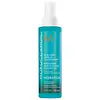What's inside
What's inside
 Key Ingredients
Key Ingredients

 Benefits
Benefits

 Concerns
Concerns

 Ingredients Side-by-side
Ingredients Side-by-side

Water
Skin ConditioningRicinus Communis Seed Oil
MaskingStearyl Alcohol
EmollientCetyl Alcohol
EmollientBehentrimonium Chloride
PreservativeButyrospermum Parkii Butter
Skin ConditioningCocos Nucifera Oil
MaskingDicaprylyl Ether
EmollientPanthenol
Skin ConditioningHydrolyzed Rice Protein
Skin ConditioningSimmondsia Chinensis Seed Oil
EmollientHydrolyzed Keratin
HumectantHydroxyethylcellulose
Emulsion StabilisingAdansonia Digitata Seed Oil
EmollientGlycerin
HumectantAloe Barbadensis Leaf Juice
Skin ConditioningMacadamia Ternifolia Seed Oil
EmollientMauritia Flexuosa Fruit Oil
Skin ConditioningVinegar
Mentha Piperita Leaf Extract
Skin ConditioningTrifolium Pratense Flower Extract
AstringentNiacin
SmoothingTocopheryl Acetate
AntioxidantHydrolyzed Vegetable Protein Pg-Propyl Silanetriol
Skin ConditioningYeast Extract
Skin ConditioningCaprylyl Glycol
EmollientCaprylhydroxamic Acid
Parfum
MaskingWater, Ricinus Communis Seed Oil, Stearyl Alcohol, Cetyl Alcohol, Behentrimonium Chloride, Butyrospermum Parkii Butter, Cocos Nucifera Oil, Dicaprylyl Ether, Panthenol, Hydrolyzed Rice Protein, Simmondsia Chinensis Seed Oil, Hydrolyzed Keratin, Hydroxyethylcellulose, Adansonia Digitata Seed Oil, Glycerin, Aloe Barbadensis Leaf Juice, Macadamia Ternifolia Seed Oil, Mauritia Flexuosa Fruit Oil, Vinegar, Mentha Piperita Leaf Extract, Trifolium Pratense Flower Extract, Niacin, Tocopheryl Acetate, Hydrolyzed Vegetable Protein Pg-Propyl Silanetriol, Yeast Extract, Caprylyl Glycol, Caprylhydroxamic Acid, Parfum
Water
Skin ConditioningCetearyl Alcohol
EmollientPropanediol
SolventCetyl Alcohol
EmollientArgania Spinosa Kernel Oil
EmollientHelianthus Annuus Seed Oil
EmollientHordeum Vulgare Seed Extract
Skin ConditioningParfum
MaskingHydrolyzed Rice Protein
Skin ConditioningHydrolyzed Quinoa
Skin ConditioningWheat Amino Acids
Skin ConditioningSoy Amino Acids
Skin ConditioningCitric Acid
BufferingGlucose
HumectantGlycerin
HumectantDimethicone
EmollientCaprylic/Capric Triglyceride
MaskingBehentrimonium Methosulfate
Stearamine Oxide
CleansingOlealkonium Chloride
Behentrimonium Chloride
PreservativeAmodimethicone
Isopropyl Alcohol
SolventCaprylic/Capric Glycerides Polyglyceryl-10 Esters
EmollientXylitylglucoside
HumectantGuar Hydroxypropyltrimonium Chloride
Skin ConditioningAnhydroxylitol
HumectantGlyceryl Stearate Se
EmulsifyingCinnamidopropyltrimonium Chloride
Xylitol
HumectantTrideceth-12
EmulsifyingPolyquaternium-7
Polyquaternium-11
C12-13 Pareth-9
EmulsifyingCetrimonium Chloride
AntimicrobialArginine Hcl
Skin ConditioningSerine
MaskingThreonine
Algin
MaskingChitosan
Potassium Sorbate
PreservativeSodium Benzoate
MaskingBenzyl Alcohol
PerfumingPhenoxyethanol
PreservativeWater, Cetearyl Alcohol, Propanediol, Cetyl Alcohol, Argania Spinosa Kernel Oil, Helianthus Annuus Seed Oil, Hordeum Vulgare Seed Extract, Parfum, Hydrolyzed Rice Protein, Hydrolyzed Quinoa, Wheat Amino Acids, Soy Amino Acids, Citric Acid, Glucose, Glycerin, Dimethicone, Caprylic/Capric Triglyceride, Behentrimonium Methosulfate, Stearamine Oxide, Olealkonium Chloride, Behentrimonium Chloride, Amodimethicone, Isopropyl Alcohol, Caprylic/Capric Glycerides Polyglyceryl-10 Esters, Xylitylglucoside, Guar Hydroxypropyltrimonium Chloride, Anhydroxylitol, Glyceryl Stearate Se, Cinnamidopropyltrimonium Chloride, Xylitol, Trideceth-12, Polyquaternium-7, Polyquaternium-11, C12-13 Pareth-9, Cetrimonium Chloride, Arginine Hcl, Serine, Threonine, Algin, Chitosan, Potassium Sorbate, Sodium Benzoate, Benzyl Alcohol, Phenoxyethanol
 Reviews
Reviews

Ingredients Explained
These ingredients are found in both products.
Ingredients higher up in an ingredient list are typically present in a larger amount.
This ingredient is a preservative and often used for it's anti-static properties. You'll most likely see this ingredient in hair conditioners.
It does not cause irritation or sensitization in leave-on products at 1-5%.
Cetyl Alcohol is a fatty alcohol. Fatty Alcohols are most often used as an emollient or to thicken a product.
Its main roles are:
Though it has "alcohol" in the name, it is not related to denatured alcohol or ethyl alcohol.
The FDA allows products labeled "alcohol-free" to have fatty alcohols.
Learn more about Cetyl AlcoholGlycerin is already naturally found in your skin. It helps moisturize and protect your skin.
A study from 2016 found glycerin to be more effective as a humectant than AHAs and hyaluronic acid.
As a humectant, it helps the skin stay hydrated by pulling moisture to your skin. The low molecular weight of glycerin allows it to pull moisture into the deeper layers of your skin.
Hydrated skin improves your skin barrier; Your skin barrier helps protect against irritants and bacteria.
Glycerin has also been found to have antimicrobial and antiviral properties. Due to these properties, glycerin is often used in wound and burn treatments.
In cosmetics, glycerin is usually derived from plants such as soybean or palm. However, it can also be sourced from animals, such as tallow or animal fat.
This ingredient is organic, colorless, odorless, and non-toxic.
Glycerin is the name for this ingredient in American English. British English uses Glycerol/Glycerine.
Learn more about GlycerinHydrolyzed Rice Protein is protein extracted from rice. This ingredient is rich in antioxidants and peptides.
Studies show this ingredient may help with blocking the melanin creation process when skin is exposed to UV.
Parfum is a catch-all term for an ingredient or more that is used to give a scent to products.
Also called "fragrance", this ingredient can be a blend of hundreds of chemicals or plant oils. This means every product with "fragrance" or "parfum" in the ingredients list is a different mixture.
For instance, Habanolide is a proprietary trade name for a specific aroma chemical. When used as a fragrance ingredient in cosmetics, most aroma chemicals fall under the broad labeling category of “FRAGRANCE” or “PARFUM” according to EU and US regulations.
The term 'parfum' or 'fragrance' is not regulated in many countries. In many cases, it is up to the brand to define this term.
For instance, many brands choose to label themselves as "fragrance-free" because they are not using synthetic fragrances. However, their products may still contain ingredients such as essential oils that are considered a fragrance by INCI standards.
One example is Calendula flower extract. Calendula is an essential oil that still imparts a scent or 'fragrance'.
Depending on the blend, the ingredients in the mixture can cause allergies and sensitivities on the skin. Some ingredients that are known EU allergens include linalool and citronellol.
Parfum can also be used to mask or cover an unpleasant scent.
The bottom line is: not all fragrances/parfum/ingredients are created equally. If you are worried about fragrances, we recommend taking a closer look at an ingredient. And of course, we always recommend speaking with a professional.
Learn more about ParfumWater. It's the most common cosmetic ingredient of all. You'll usually see it at the top of ingredient lists, meaning that it makes up the largest part of the product.
So why is it so popular? Water most often acts as a solvent - this means that it helps dissolve other ingredients into the formulation.
You'll also recognize water as that liquid we all need to stay alive. If you see this, drink a glass of water. Stay hydrated!
Learn more about Water